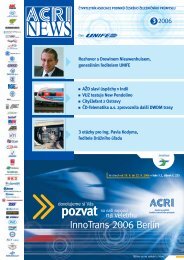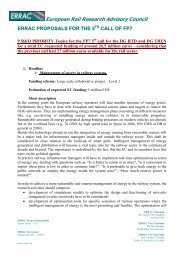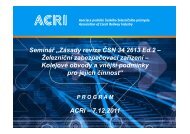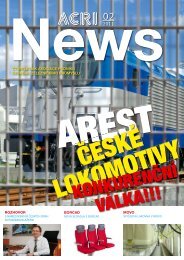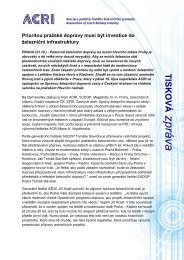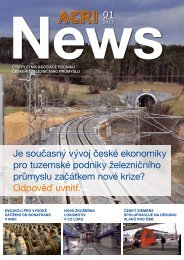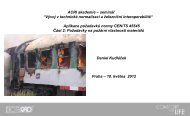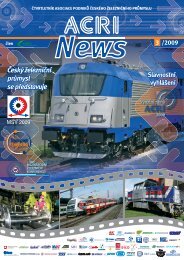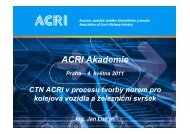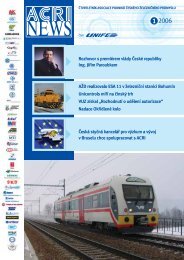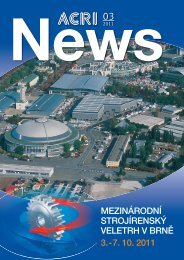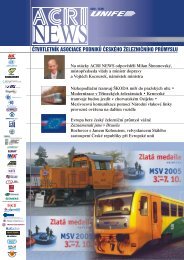You also want an ePaper? Increase the reach of your titles
YUMPU automatically turns print PDFs into web optimized ePapers that Google loves.
News<br />
strana 26<br />
Brussel´s news<br />
The future<br />
high-speed rail network:<br />
complete, connected,<br />
and consistent<br />
European and national politicians need to avoid building a “Two(high)<br />
Speed” Europe. This was the main message delivered at the event<br />
“Putting European high-speed rail on the fast track” co-organised by<br />
the Polish Presidency and CER on 19 October. Hosted by the European<br />
Parliament’s EPP Group, the political debate gathered high level<br />
representatives from the European Commission, Parliament, Council,<br />
and the rail sector. Participants discussed possible ways how to fulfill the<br />
European Commission’s objective to triple the length of high-speed lines<br />
in Europe by 2030, as stated in the 20<strong>11</strong> Transport White Paper.<br />
In his introductory remarks, Andrzej Massel,<br />
Polish Vice-Minister of Infrastructure,<br />
current Vice-Chairman of the Transport<br />
Council, underlined the importance of<br />
European and national authorities joining<br />
forces to bridge the existing gap between<br />
Western Europe and Central and Eastern<br />
Europe and welcomed the publication of<br />
the TEN-T guidelines on the same day. With<br />
high-speed, rail will become more competitive<br />
towards other modes of transport,<br />
thereby helping to reduce CO 2 emissions in<br />
line with White Paper’s objectives.<br />
Poland is actively working on a high-speed<br />
rail network. Zbigniew Szafrański, President<br />
of the Management Board of PKP PLK<br />
S.A, reminded that the first High-Speed<br />
line was built in 1977 in Poland, originally<br />
meant for freight, but with the vision of<br />
trains running at 250km/hr. He underlined<br />
the need to modernize the existing Polish<br />
network as well as to build new high-speed<br />
lines.<br />
Looking at the opportunities of connecting<br />
high-speed rail to road and aviation routes,<br />
Jean-Eric Paquet, Director of European Mobility<br />
Network in DG MOVE, presented the<br />
main lines of the revised TEN-T guidelines<br />
and the Connecting Europe Facility, published<br />
by the European Commission on the<br />
day of this event. In line with the Transport<br />
White Paper, the new TEN-T network sees<br />
rail as the backbone of European transport,<br />
reflecting the Commission’s intention<br />
to promote inter-city high-speed rail links<br />
and to connect airports to (high-speed)<br />
rail.<br />
MEP Artur Zasada (EPP, PL) confirmed the<br />
Commission’s view about the complementarity<br />
between rail and air. Improving rail<br />
connections between airports and cities as<br />
well as between airports is crucial, especially<br />
in crisis situations such as the Icelandic<br />
ash cloud in the air transport sector.<br />
The natural alternative during such extreme<br />
situations should be high-speed rail.<br />
He mentioned the current work on the “Y”<br />
project between Warsaw, Wroclaw, Poznan<br />
and Krakow, the first-high speed project in<br />
Central and Eastern Europe.<br />
Michel Jadot, Director General of SNCB/<br />
NMBS, presented the views of a carrier<br />
operating in a country situated in the centre<br />
of an already well developed and busy<br />
high-speed rail network, the well-known<br />
“London-Paris-Brussels-Cologne-Amsterdam”<br />
area. As a relatively small operator,<br />
SNCB is taking strong positions in distribution<br />
and is developing partnerships with<br />
other rail operators as well as airlines.<br />
Finally, as underlined by MEP Bogdan Kazimierz<br />
Marcinkiewicz (EPP, PL), reducing the<br />
dependence of the European Union to oil is<br />
also one of the objectives of the Commission’s<br />
Transport White Paper. To further develop<br />
rail traffic will be crucial to increase<br />
the EU’s energy independency.<br />
Concluding the discussions, CER Deputy<br />
Executive Director Libor Lochman, stated<br />
that “a complete, connected and consistent<br />
high-speed network is the future of<br />
medium and long-distance rail services,<br />
both passenger and freight. However,<br />
member states and the EU will have to<br />
ensure that the level playing field is established<br />
across all transport modes and<br />
that building a high-speed EU network will<br />
not be done at the expense of conventional,<br />
i.e. intercity and regional, passenger<br />
services. Not only the high-speed railway<br />
networks should be connected, but they<br />
should also be consistent with and complementary<br />
to a well-functioning conventional<br />
railway network”.<br />
Source: CER



